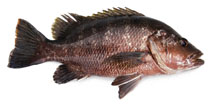| Family: |
Lutjanidae (Snappers), subfamily: Lutjaninae |
| Max. size: |
100 cm TL (male/unsexed); max.weight: 19 kg |
| Environment: |
benthopelagic; freshwater; brackish; marine, catadromous |
| Distribution: |
Oceania: known only from southern Papua New Guinea between the Port Moresby district and the Fly River. |
| Diagnosis: |
Dorsal spines (total): 10-10; Dorsal soft rays (total): 13-14; Anal spines: 3-3; Anal soft rays: 8-8. Dorsal profile of head steeply sloped. Preorbital bone relatively broad, usually much greater than eye diameter. preopercular notch and knob poorly developed. Scale rows on back parallel to lateral line anteriorly. There are distinct color phases with the entire body blackish or with a series of 6 or 7 broad greyish bars on sides. Juveniles usually banded (Ref. 48635). |
| Biology: |
Adults inhabit large freshwater streams. Not reliably reported from marine habitats but may occur in estuaries. Larval stages are probably marine. Juveniles of adolescent fish may occur in mangroves and could be mistaken for the mangrove jack L. argentimaculatus that has a similarly banded pattern in such habitats (Ref. 48635). It is a popular sport fish forming the basis of a safari-angling industry. |
| IUCN Red List Status: |
Not Evaluated (N.E.) Ref. (130435)
|
| Threat to humans: |
harmless |
| Country info: |
|
Source and more info: www.fishbase.org. For personal, classroom, and other internal use only. Not for publication.

